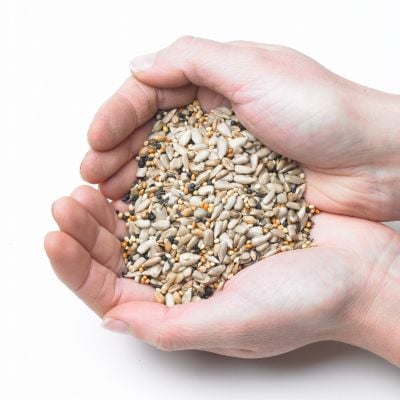Yellowhammer Factfile
Although not a common garden bird, Yellowhammers will, locally, visit relatively open gardens and often when close to farmland with hedgerows. The male bird is unmistakable with its bright yellow head and yellow underparts (the yellow is much less pronounced outside of the breeding season), streaked brown and black back, and white outer tail feathers which are obvious in flight. The female lacks the bright yellow colour of the male, though has a similar plumage pattern overall.
Video footage of Yellowhammers
Yellowhammer nesting and breeding habits
The Yellowhammer typically builds its nest on or very near the ground, and in a tuft of vegetation or close to, or just in, a bush or hedgerow. The nest is a cup of grass, plant stems, then lined with fine plant material or hair. There are two, sometimes three, broods per season, with 3-4 eggs in each clutch which the female incubates alone and fed by the male bird. Both parents feed the young.
Yellowhammer history and population trends
A rapid decline in the population of the Yellowhammer has taken place since the mid-1980s. However, there has not been a uniform pattern across the UK for this decline, with the population actually increasing in Scotland over the last 10 years or so. As is the case for so many of our songbirds, modern farming practices are likely to be partly responsible for the Yellowhammer’s population decline
Behaviour traits of Yellowhammers
Probably the most notable behaviour of the Yellowhammer is its habit of perching on an exposed branch on a bush or in a hedgerow, and repeating its distinctive short song.
Yellowhammer diet and food
The diet of the Yellowhammer is rather varied, and consists of seeds, grain, some small fruits such as blackberries, insects and spiders. In the garden, Yellowhammers will feed on the ground or a ground table, with Premium Finch Mix being an ideal food.
What should I feed Yellowhammers?
Populations of Yellowhammers are relatively local and tend to be in rural areas where there’s non-intensive arable farming. If you live in such an area, then the species can be fairly easy to attract with seed and seed mixes like the one below, and fed direct on the ground, a ground tray or a bird table.
Frequently Asked Questions
Why are they called Yellowhammers?
Yellowhammers got their name from the partly bright yellow plumage of the male bird, with the second element of the name being derived from the German word for bunting (which is the family of bird Yellowhammers are in) which is ‘ammer’.
Where do Yellowhammers go in winter?
During the winter months, Yellowhammers join other species of bunting and also finch, and will roam widely across farmland and heaths etc. in search of seed and grain.
Do Yellowhammers flock?
Yellowhammers do flock, but only outside the breeding season when they often form quite large flocks which include other species of bunting, plus finches as well.
What does a female Yellowhammer look like?
Female Yellowhammers have very similar plumage markings to the male (see image on this page) but lack the bright yellow colour and are more brown overall.
Are Yellowhammers endangered?
Yes, Yellowhammers are endangered, and following many decades of decline in breeding numbers (mainly as result of intensive farming methods), are a red listed species in the UK.







